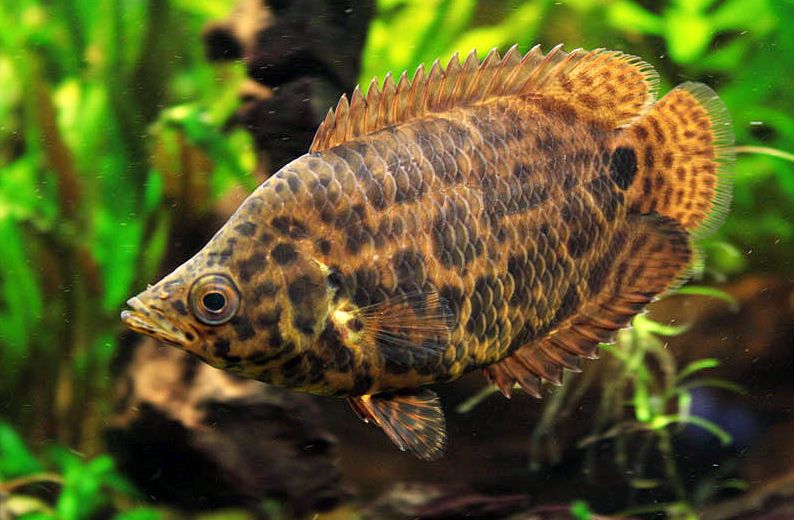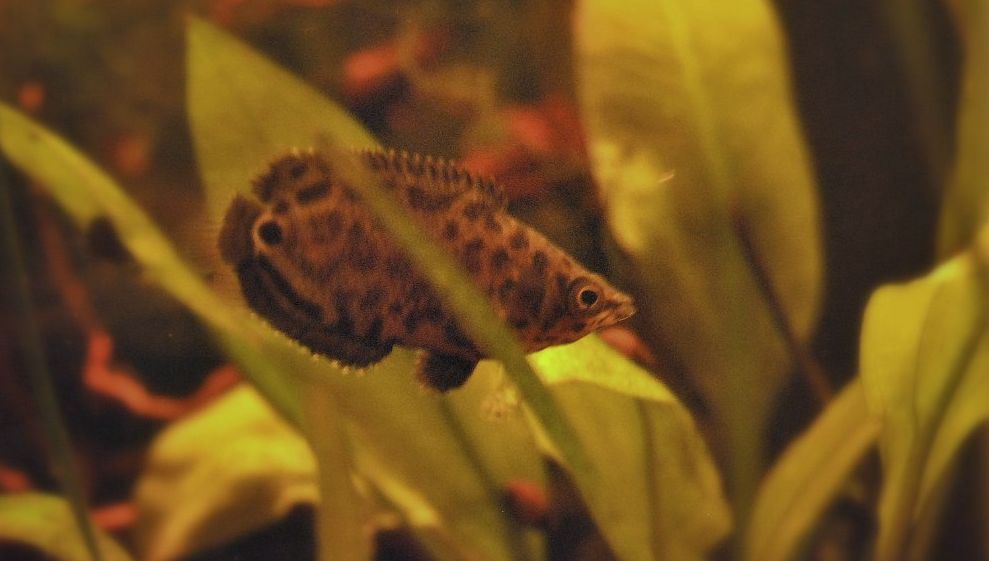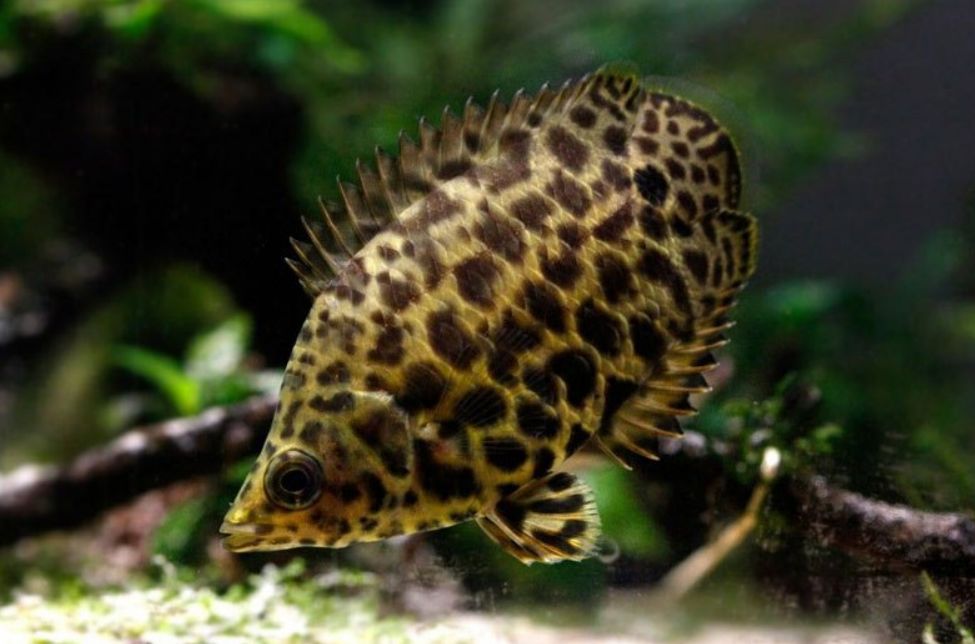The leopard bush fish (Ctenopoma acutirostre), also known as the spotted ctenopoma, belongs to the Anabantidae family and is a fascinating addition to any aquarium. This fish is naturally predatory, preying on small tank inhabitants that it can swallow. Its diet typically includes juveniles, small fish, various amphibians, fish eggs, insects, shellfish, small crustaceans, and other spineless species.

Contents
Habitat in the wild
The leopard ctenopoma, a species from the Anabantidae family, is a captivating freshwater fish native to various regions of Africa, particularly in the Congo river basin within the modern Republic of the Congo and the Democratic Republic of the Congo. These fish thrive in diverse habitats, including slow-moving rivers, streams, ponds, swamps, and marshes, where dense vegetation provides ample cover.
Adapted to their natural environment, leopard ctenopomas are shy and reclusive. They prefer to hide among submerged plants, fallen branches, and debris, making them most active during the night. During the day, they often seek refuge in the thick underwater vegetation, avoiding direct exposure.
As opportunistic predators, leopard ctenopomas primarily feed on small invertebrates, insects, and crustaceans. They exhibit a unique hunting strategy, often waiting patiently in disguise until their prey comes within striking distance. While they can become excited during the hunt and chase their prey, they typically prefer to attack from concealment, taking advantage of their environment to secure a meal.
Description
Size
Adult leopard ctenopomas can reach up to 20 cm (8 in) in length in their natural habitat. However, in an aquarium setting, they rarely exceed 15 cm (6 in). It’s important to note that the size of the aquarium and the overall environment play crucial roles in the fish’s well-being and development.
Lifespan
On average, leopard bush fish can live between 5 to 8 years in captivity, with some individuals potentially living even longer when given proper care. To enhance their overall health and longevity, it’s crucial to provide them with a suitable environment, a balanced diet, and regular maintenance of water quality.
Body and color
The leopard bush fish features a tall, slightly flattened body with an elongated mouth and large eyes, making it distinctive among freshwater species. This fish can subtly change its coloration to blend with its environment or convey its mood; for instance, it may darken when feeling threatened or stressed.
Its body is adorned with a striking pattern of dark spots scattered over a yellowish-brown background, reminiscent of a leopard’s coat. This unique coloring serves as effective camouflage among aquatic vegetation in its natural habitat. The spots vary in hue from dark brown to black, creating a beautiful contrast against the lighter body. Additionally, a prominent vertical stripe of bright color is visible on the tail stem.
The tail of the leopard bush fish is darkly colored, which can obscure the fish’s actual size. Notably, there is a spot on the tail that resembles an eye. In some individuals, the dark coloration may be so pronounced that the spots become barely visible, adding to the fish’s intriguing appearance.
| Characteristic | Description |
|---|---|
| Scientific Name | Ctenopoma acutirostre |
| Common Name | Leopard Ctenopoma, Leopard Bush Fish, Spotted Climbing Perch, Spotted Ctenopoma, Spotted African Leaf Fish |
| Family | Anabantidae |
| Native Region | Central and Western Africa |
| Habitat | Slow-moving rivers, streams, ponds, swamps, marshes |
| Preferred Water pH | Slightly acidic to neutral (pH 6.0 to 7.0) |
| Preferred Water Temperature | 72°F to 82°F (22°C to 28°C) |
| Size | Up to about 4-6 inches (10-15 cm) in length |
| Lifespan | Around 5 to 8 years in captivity |
| Behavior | Shy and reclusive, seeks refuge in vegetation and cover |
| Diet | Carnivorous, feeds on small invertebrates and insects |
| Special Feature | Possesses a labyrinth organ to breathe atmospheric air |
| Aquarium Requirements | Plenty of hiding spots, access to the water surface for breathing, a well-maintained planted aquarium |

Difficulties in keeping
The leopard bush fish is a resilient and undemanding species, often recognized as a long-lived relative within its family. Despite its hardiness, this fish is quite timid and prefers to remain close to dense vegetation and submerged structures, where it feels secure. Most of its time is spent hiding in these areas, reflecting its calm and peaceful temperament.
Typically, the leopard bush fish tends to stay near the bottom of the tank and rarely ventures higher than the mid-water level. Its unique coloration and body shape make it difficult for other predatory fish to spot, allowing it to blend seamlessly into its surroundings. Most active at night, this fish enjoys the thrill of chasing smaller tank inhabitants, showcasing its predatory instincts while still maintaining a generally peaceful demeanor.
Keeping in a tank
Tank size
For a single leopard bush fish, a minimum tank size of around 75 to 114 liters (20 to 30 gallons) would be suitable. To keep a couple, it’s recommended to have a thickly planted tank with a capacity of at least 190 liters (50 gallons). However, considering their territorial nature, if you intend to keep multiple leopard bush fish together, you’ll need a larger tank to accommodate their potential territorial behaviors, ideally at least 265 liters (70 gallons) or more.
Decorating the tank with branchy snags, caves, and stony hills while leaving enough open space for swimming is essential. A larger tank with ample swimming space and multiple hiding spots will help reduce aggression and stress among the fish. Having live plants and decorations will create a more natural and stimulating environment, providing cover and hiding places.
Since leopard bush fish are territorial, it’s not advisable to introduce new tank dwellers into an established community, as this can lead to territorial conflicts. The best option for successfully keeping these fish is a species tank with a large bottom area.
Water parameters
Here are the optimal tank water parameters for leopard bush fish:
Temperature: Maintain the water temperature between 22°C and 28°C (72°F to 82°F). Avoid drastic fluctuations, as they can stress the fish.
pH Level: Leopard bush fish prefer slightly acidic to neutral water, with a pH range of around 6.0 to 7.0.
Water Hardness: Aim for moderate water hardness, ideally between 5 to 15 dGH (degrees of general hardness).
Ammonia and Nitrite: Keep ammonia and nitrite levels at 0 ppm (parts per million), as both are toxic to fish and can harm their health.
Nitrate: Maintain low nitrate levels, ideally below 20 ppm. Regular water changes and proper filtration help keep nitrates low.
Filtration: Ensure good water quality by providing appropriate filtration for the tank. Regular water changes and monitoring of water parameters are essential for the health of leopard bush fish.
Water Movement: These fish are from slow-moving waters, so avoid strong currents in the aquarium. Gentle water circulation is sufficient, as excessive movement can stress the fish.
Lighting
The leopard bush fish thrives in dim lighting rather than bright tank illumination. To achieve this effect, consider using floating plants like Amazon frogbit or water lettuce, which can help scatter light naturally and create a more comfortable environment for the fish. These plants not only provide shade but also enhance the overall aesthetic of the aquarium while benefiting the fish’s well-being.
Diet
The leopard bush fish is a carnivorous species that primarily feeds on small invertebrates and insects. In their natural habitat, they are opportunistic predators, targeting various aquatic and terrestrial prey.
In the wild, leopard bush fish consume insects such as flies, mosquitoes, and small crustaceans. They are skilled hunters, utilizing their excellent camouflage and patience to ambush prey. Their elongated body and large mouth enable them to swiftly snatch up food within striking distance.
For leopard bush fish in captivity, consider the following suitable foods:
Live or Frozen Foods: Live bloodworms, tubifex, and similar-sized live foods are ideal, closely resembling their natural diet. If live food is unavailable, frozen options like shrimp and bloodworms can also provide optimal nutrition. The fish will eagerly chase and consume these.
Pellets and Flakes: While leopard bush fish may be reluctant to eat pellets initially, you can gradually train them to accept high-quality commercial fish pellets and flakes designed for carnivorous species. Look for products specifically labeled for carnivorous fish.
Small Fish: Occasionally, leopard bush fish may accept small fish as part of their diet. Ensure that the fish are appropriately sized and healthy to avoid any choking hazards or disease transmission.
Insect-Based Foods: Specialty fish foods containing insect meal and other nutritious ingredients can also add dietary variety.
Plant Food: There is no need to provide plant food, as leopard bush fish do not require it in their diet.
Tank mates
There are almost no issues with the bush fish compatibility in a tank. The tank mates can be fishes of the similar size which require the same tank conditions These can be angelfish (or another cichlids) that are quite common dwellers in amateur tanks, swordtails and other fishes which size is large enough, so they won’t be swallowed by a ctenopoma.
Small sized species representatives (neon tetra fishes, guppy, etc.) can be treated by the fish as a potential prey. Since the fish has only one restriction: its prey should fit its mouth, which is rather large.
However, you shouldn’t keep a fish together with cichlid species which are too aggressive, since they’ll definitely attack this calm and a bit timid fish.
The fish demonstrates rather tolerant behavior towards other species (like bichir or african cichlids) of similar size and it can become rather timid, since other active tank mates may scare it. Therefore, to make sure that the fish won’t get stressed it is a must to have shelters in the tank. Flower pots, halves of coconut shells, thickly growing tank plants may be used as ones.
Intraspecific interactions between the fish species are based on dominance of alpha male on a specific territory and therefore in small tanks territorial fights are quite possible. You can avoid the issue, if the fish species grow up together and form their hierarchy as they grow.

Gender differences: male vs female
Determining the sex of leopard bush fish can be challenging, particularly when they are young or not in breeding condition. However, several key differences can help distinguish males from females as they mature:
Size: Males tend to be slightly larger than females. As they reach maturity, this size difference becomes more noticeable, with males exhibiting a more elongated and robust body.
Dorsal Fin: The dorsal fin of males is usually more elongated and pointed compared to that of females. Males may also display more intense or prominent coloration in their dorsal fin.
Anal Fin: Similar to the dorsal fin, males typically have an anal fin that is more elongated and pointed than that of females.
Coloration: Both males and females share the characteristic leopard-like spotted pattern, but males often exhibit more vibrant colors, especially during the breeding season. Females may have slightly duller coloration.
Behavior: During breeding season, males may show more territorial and aggressive behavior, particularly toward other males. They might also engage in courtship behaviors, such as chasing females and preparing nests.
Breeding Tube: In mature males, a breeding tube—a tubular structure located behind the anal fin—becomes visible during the breeding season, which is absent in females.
Breeding
Breeding leopard bush fish in an amateur aquarium can be quite rare, as they are selective in choosing mates. The chances of forming a successful pair increase if you start with a group of several young fish of the same age.
As they mature, these fish tend to pair off on their own. It’s believed that spawning occurs during specific seasons, with regular breeding cycles followed by periods of inactivity.
During the mating season, the fish engage in unique courtship displays, releasing hundreds of eggs that float to the water’s surface. Unfortunately, leopard bush fish lack developed parental instincts and do not care for their offspring. In fact, adult fish may eat their own eggs, so it’s essential to carefully remove the eggs and transfer them to another tank with matching water parameters.
Since the eggs are buoyant, they float on the surface. Unlike other climbing perches, leopard bush fish show no concern for their eggs, allowing you to remove the parents immediately after spawning.
The eggs typically hatch within about 48 hours. Despite their relatively large size, the larvae that emerge are small and possess a large yolk sac. Within two days, the yolk sac is fully absorbed, and the larvae grow significantly, becoming juveniles that actively swim in search of food.
Brine shrimp nauplii are an excellent starting feed for these juveniles. Although leopard bush fish can produce thousands of eggs, the survival rate of the juveniles in aquarium conditions is often very low.